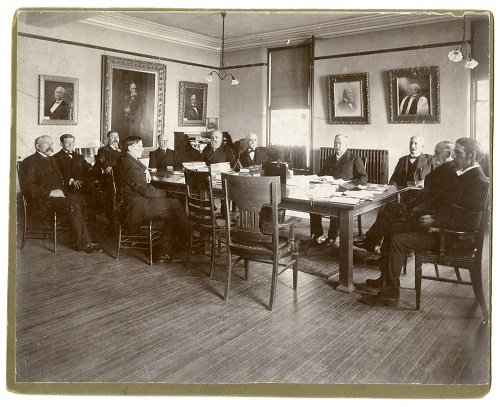The first Board of şĂɫСŇĚ was elected in February 1851 as part of the founding of the University of Minnesota. Until 1860, the Board consisted of 12 şĂɫСŇĚ elected by the legislature, as directed by the University Charter.
The 1860s marked a period of financial difficulties for the University. In 1861, the University suspended operations, and the legislature passed a law creating a temporary Board of only three şĂɫСŇĚ: John Pillsbury, O.C. Merriman, and John Nicols. Their main goal was to eliminate the University’s debt—a goal achieved by 1867, when the University reopened.
The Board grew to 7 members in 1868, 9 in 1889, and 10 in 1923. Following the Minnesota Supreme Court's Chase decision in 1928, which reaffirmed the University’s constitutional autonomy from the State, the Board was restored to 12 members.
Today, the Board remains a 12-member body elected during a joint convention of the Minnesota House and Senate. One member is elected from each of Minnesota's eight Congressional districts. Four seats are at-large. Since 1976, one of the at-large seats has been held by a Regent who is a University of Minnesota student at the time of election.
Important Firsts
- Stephen Mahoney, 1889—first University alumnus to serve as a Regent
- Alice Warren, 1922—first female RegentÂ
- Josie Johnson, 1971—first African-American Regent
- Michael Unger, 1976—first student to hold an at-large seat
- Wenda Moore, 1977-84—first female Chair of the BoardÂ
- Hyon Kim, 1994—first Asian-American Regent
- Maureen Ramirez, 2007—first Latina Regent
- Tadd Johnson, 2022—first Native American RegentÂ
Fun Facts
- John Pillsbury is the only person made Regent for Life by the Minnesota Legislature.
- Fred Snyder is the longest-serving Chair of the Board, serving from 1914 to 1950.Â
- Former Supreme Court Justice and professional football player Alan Page served on the Board from 1989 to 1993.Â
- William J. Mayo, one of the Mayo brothers, founders of the Mayo Clinic, served on the Board from 1907 to 1939.Â
- şĂɫСŇĚ have come from a variety of backgrounds—from farmers to governors, physicians to media executives, CEOs to teachers, legislators to entrepreneurs, and lawyers to lumber millers.
şĂɫСŇĚ Seal
The şĂɫСŇĚ Seal was adopted by the Board of şĂɫСŇĚ in 1939 as the corporate seal of the University of Minnesota. The Latin motto, Omnibus artibus commune vinculum, means “a common bond for all the arts.” The lamp represents the metaphysical sciences, the telescope the physical sciences, the plow the industrial arts, and the palette and brushes the fine arts.
